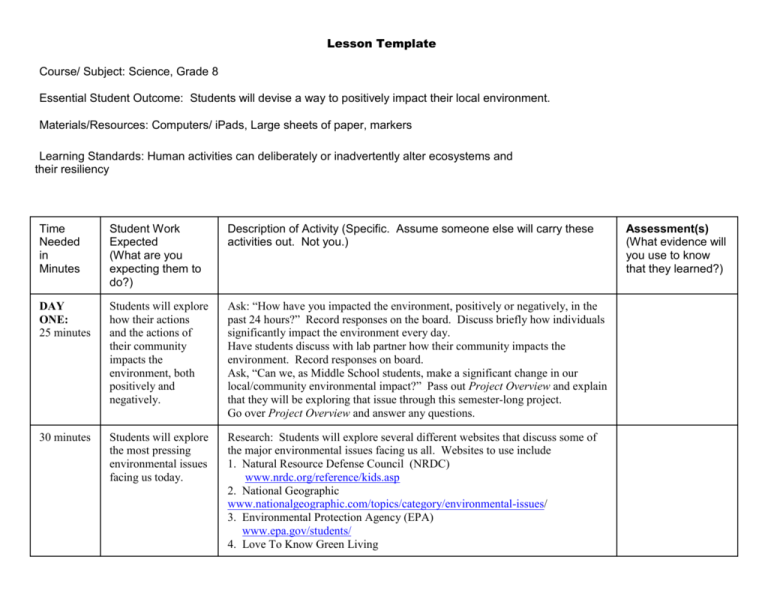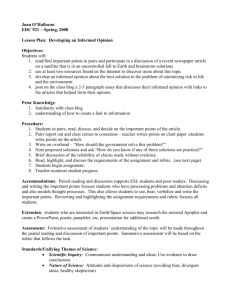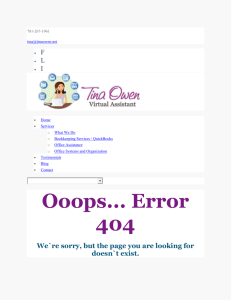students for change
advertisement

Lesson Template Course/ Subject: Science, Grade 8 Essential Student Outcome: Students will devise a way to positively impact their local environment. Materials/Resources: Computers/ iPads, Large sheets of paper, markers Learning Standards: Human activities can deliberately or inadvertently alter ecosystems and their resiliency Time Needed in Minutes Student Work Expected (What are you expecting them to do?) Description of Activity (Specific. Assume someone else will carry these activities out. Not you.) DAY ONE: 25 minutes Students will explore how their actions and the actions of their community impacts the environment, both positively and negatively. Ask: “How have you impacted the environment, positively or negatively, in the past 24 hours?” Record responses on the board. Discuss briefly how individuals significantly impact the environment every day. Have students discuss with lab partner how their community impacts the environment. Record responses on board. Ask, “Can we, as Middle School students, make a significant change in our local/community environmental impact?” Pass out Project Overview and explain that they will be exploring that issue through this semester-long project. Go over Project Overview and answer any questions. 30 minutes Students will explore the most pressing environmental issues facing us today. Research: Students will explore several different websites that discuss some of the major environmental issues facing us all. Websites to use include 1. Natural Resource Defense Council (NRDC) www.nrdc.org/reference/kids.asp 2. National Geographic www.nationalgeographic.com/topics/category/environmental-issues/ 3. Environmental Protection Agency (EPA) www.epa.gov/students/ 4. Love To Know Green Living Assessment(s) (What evidence will you use to know that they learned?) greenliving.lovetoknow.com/Top_30_Environmental_Concerns 30 minutes Students will research an environmental issue of interest and fill out Initial Information Sheet. Students will choose one issue that interests them the most. They will do a brief web search and fill out the Initial Information Sheet about their chosen issue. DAY TWO Students will share their information Students will share their information with the class. DAY THREE Students will choose their topic of interest PREPARATION: Go through the Initial Information Sheets and divide the issues chosen into broad categories (ie, Water, Deforestation, Wildlife Conservation, etc.) Make a sign for each category and tape these around the room. 25 minutes Students will be teamed up according to their topic of interest. Students will create a team Google Docs folder and individual Journals Have students move to the sign for the issue that most closely represents their chosen environmental problem. Explain to students that they will be working in groups of 4 to explore their environmental issue and come up with a workable solution for positive community impact for that issue. Divide the students into groups of 4. Have students set up a Google Docs folder for keeping and sharing their project. Have each student set up a Journal Doc. They will put at least one entry per week in their Journal that reflects what they’re learning, their thoughts and their ideas. Students share their Initial Information Sheet with teacher Weekly Journal entries (each student) 20 minutes 30 minutes Students will explore website credibility. Students will find three credible web sources for their research. Discuss with students the necessity for assessing the value of a website when researching a topic. Hand out / share copy of Rubric to Determine Credibility of a Website. Model using the rubric to assess two different websites: a credible and a less-than-credible. Suggested websites might include http://animals.about.com/od/molluscs/a/octopus-facts.htm (credible) and http://zapatopi.net/treeoctopus/ (not credible). Inform students that they will be researching their topic and must include three sources for their research. Each source must include a completed Credibility Rubric. Students will share their research with team members. Have student groups discuss what they know about their topic, including the information they obtained when filling out their Initial Information Sheets. Explain to the teams that their goal is to come to a deep understanding of the issue and then come up with a workable solution that they themselves could carry out. The solution should be economically viable, feasible, and effective in creating community change. Credibility Rubric Have student teams divide up the research evenly among the group. Students will do their part of the research and come to class with significant information about their topic. Remind students that the goal of their research is to come to a deep understanding of the issue, the problems inherent in solving the problem, solutions that have been tried, and the success of those solutions. All research will be written in Google Docs and shared with the group and the teacher through the group folder. If time allows, students can begin their research HOME ASSIGNMENT Students will complete their research Students will research their issue DAY FOUR 20 minutes) Students will share their research with their team members Students will take turns sharing their research with their team members. Student teams will make notes about the most important and interesting facts they have discovered, as well as questions that arise. Research will be shared with the group & teacher, and assessed according to the Research Rubric 20 minutes 20 minutes Students will explore youth blog sites that deal with environmental issues Student teams will set up their own blog using StVrainBLOGS http://blogs.svvsd.org Have students log into and explore TakingITGlobal and Young Voices for Climate Change, paying particular interest towards how young people across the globe are involving themselves in finding viable solutions for environmental issues. Pass out Team Blog Log, one per team. Have students count off, 1-4. Explain that each week, one team member will be in charge of blogging about the team’s progress, including what they’ve learned, what they’re planning, and their project progress. Instruct student teams to fill in the names of their team members … #1 will be the first blogger, #2 will be second and so on until the chart is filled. Have students set up a blog on StVrainBLOGS. Make sure they share it with the teacher as administrator. 20 minutes Student teams will create their first blog. ASSIGNMENT Student will continue their research DAY FIVE Brainstorm action ideas 20 minutes 20 minutes Brainstorm, part two 20 minutes 20 minutes DAY SIX Choose a solution Have student teams work together to create their first blog. In the blog, they should share a bit about who they are, what their topic is, and what they’ve discovered so far. Have students go back to their notes and research some more in an effort to answer the questions that have arisen. Share new research on GoogleDocs Student teams do the following exercises in order to identify a feasible solution to their problem. Give each team a large piece of paper and markers. 1. Reduce the problem … for example, imagine the problem was only one water bottle, instead of a million. What could you do? (5 minutes) 2. Imagine you are a superhero. How would you solve the problem? (5 minutes) 3. Travel forward in time … how would people solve this problem 200 years from now? (5 minutes) Prototype Students will now brainstorm ideas for solutions that are feasible and effective. Hand out another large piece of paper. Explain to students that they will now be creating a list of 25 solutions to their problem. Students will discuss the ideas and develop a workable solution. Remind teams that the solution may involve a combination of ideas. They will create a “prototype” of their solution. Present Prototype Student teams present their ideas in class and receive feedback. Weekly Team Blog Log 30 minutes 20 minutes 20 minutes DAY SEVEN 30 minutes 45 minutes WEEKLY CHECKIN, every Monday FINAL PRESENT ATION Redesign List materials and estimate cost Develop plan of action Begin implementation Students present their project to the class Student teams make modifications to their ideas based on class feedback. Students will make a list of materials they will need and research the cost of the different components Students will develop a step-by-step plan for implementing their solution. Student teams will fill out their Action Plan, including who does what, key dates, and specific actions. Students begin implementation of their plan. This could be making their posters, researching key individuals in the community that will be instrumental in their solution, writing letters to the city, etc. Students will check – in with the teacher on a weekly basis, showing their progress in implementing their solution, any problems they have encountered, and any modifications they have made. This check –in will be done online, using the Team Check-In sheet. Presentation will include their project, how they’re implementing it Prototype Action Plan Weekly Check-In, Final Presentation Rubric STUDENTS FOR CHANGE PROJECT OVERVIEW DESCRIPTION: Over the course of this semester, you are going to become an agent for change! Students around the globe are taking a stand on issues that affect them, their families, and their communities. They are using their amazing curiosity and creativity to come up with viable solutions to pressing environmental problems. And you can too!! Here’s the project: You and a team of three other students will learn everything you can about a chosen issue facing your community. Then, you will formulate a solution for the issue and actually implement the solution!! You will make a difference!! The in-class part of this project will be limited to the first couple of weeks, The bulk of the project will be done outside of school, using Google Docs to communicate with your teammates. You will be expected to keep a journal of your project and blog weekly about what you’ve learned. GRADING: This project will take the place of your Semester Final Exam. The grade will be broken down according to the rubric on the following page. DUE DATE: DECEMBER TASK INITIAL INFORMATION SHEET JOURNAL ENTRIES SOURCE CREDIBILITY SHEET RESEARCH #1 TEAM BLOG LOG RESEARCH #2 PROTOTYPE #1 REVISED PROTOTYPE MATERIALS LIST ACTION PLAN WEEKLY TEAM CHECK-IN FINAL SOLUTION IMPLEMENTATION FINAL PRESENTATION INDIVIDUAL PARTICIPATION: 1. 2. 3. 5 POINTS 4 POINTS 3 POINTS 2 POINTS 1 POINT 4. PROJECT TOTALS FINAL SCORE: ___________________ 150 www.kidsnetsoft.com/internet/rubric.doc Criteria Author Identification. Sponsoring organization. Last updated Author contact Factuality Source of information and ethics Purpose 3 2 1 The author's name is easy to find and it appears as though s/he would be an authority on the subject. A well-known respectable organization is clearly identified as a sponsor of the site. Current Event: updated within the last month. Historical Topic: updated within the last year. The author’s name can be found, but s/he may or may not be an authority on the subject. The author is unknown. A sponsoring organization can be identified, but its reputation in relation to the topic is questionable. No sponsoring organization can be identified. Current Event: updated one to six months ago. Historical Topic: updated one to two years ago. The author’s contact is easy to find and is available through a direct link. The website gives just the facts and seems to be free from opinions or bias. The author explains where most information came from and provides direct links to original information. The purpose of the site is to inform and educate its audience. The author’s contact information may be difficult to find/is not available through a direct link. The website appears to be factual, but the author's opinions are frequently revealed. The author occasionally explains where information came from but does not provide direct links to original information. The purpose of the site is mainly to persuade the audience to think a certain No date is shown or information is outdated: Current Event: more than six months old. Historical Topic: more than two years old. No author contact can be found. Facts are questionable, based mostly on the author's opinions. The author never explains or identifies the source of information. The main purpose of the site is to sell a product or idea for the Rating way. creator's personal gain.




